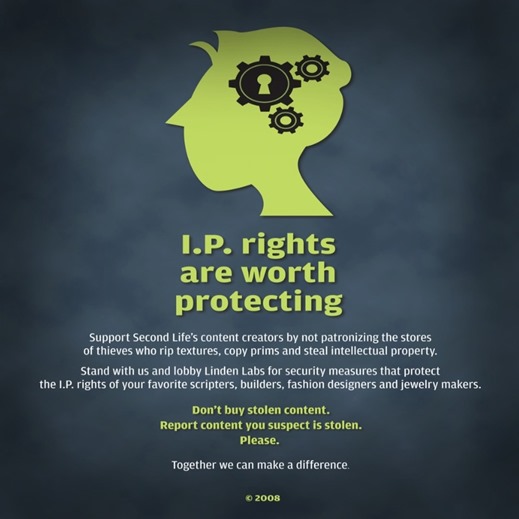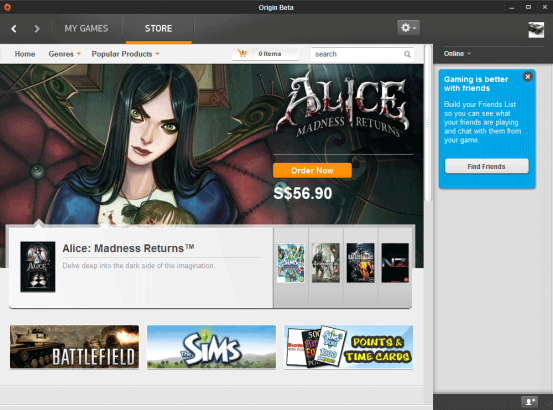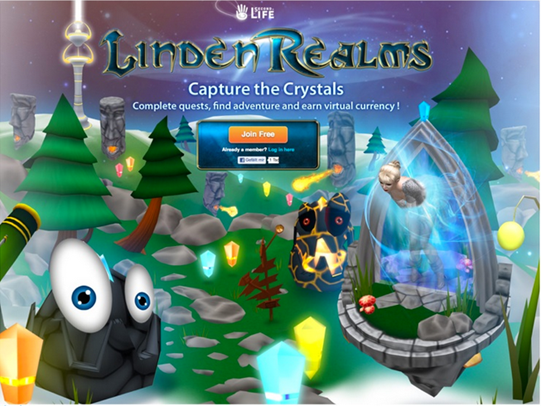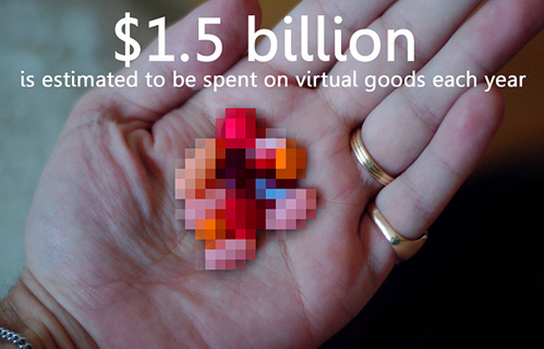A hypothetical outcome for the #SecondLife TOS situation
Recently, I posted a write-up about the Modus Operandi for the TOS changes for Second Life, and it was a bit of a rant with a heavy dose of satirical elements. What I didn’t post, which I will here today, is a hypothetical reasoning from a business perspective concerning why Linden Lab sees a reason to assign themselves unrestricted rights to everything in Second Life.
Usually, I’m known for my nebulous rants and tongue-in-cheek monologues. Most of the time I’m just posting a stream of consciousness and it may or may not have a bearing to actual reality but more often is just a raw perception of a situation. In this post, you’re going to see a more sober version of me – the side that corporations usually see behind closed doors when I’m trend-forecasting or re-organizing structure in a serious manner, or the side that addresses a room full of NASA project leaders. Contrary to popular belief, I’m not as random as most would think (though more often than not I portray otherwise publically with a hidden grain of truth to what I’m saying).
Today, I’m going to be serious because this is a very serious matter and it needs to be addressed without the frivolity or sarcasm.
 The irony of this poster 5 years later...
The irony of this poster 5 years later...
On the surface, one could argue that just because they have seen fit to assign themselves unrestricted access and ownership to your creations, and shown absolutely no concern or remorse for the collateral damages this would cause, that they have some nefarious plot underway. Of course, you can also take their word at face value when they say that they would never betray the community like that and you have nothing to worry about.
Being forever the pragmatist, I take neither revelation as true, but instead somewhere in the middle. But in order to figure out the purpose for such a TOS change, one must take a step out of Second Life and really look at the bigger picture.
Let’s begin by stating what is actually the problem block of text in all of this, which is to say Section 2.3, so that we may better wrap our heads around what this would imply:
2.3 You grant Linden Lab certain licenses to your User Content.
[..]you agree to grant to Linden Lab, the non-exclusive,unrestricted, unconditional, unlimited, worldwide, irrevocable, perpetual, and cost-free right and license to use, copy, record, distribute, reproduce, disclose, sell, re-sell, sublicense (through multiple levels), modify, display, publicly perform, transmit, publish, broadcast, translate, make derivative works of, and otherwise exploit in any manner whatsoever, all or any portion of your User Content (and derivative works thereof), for any purpose whatsoever in all formats, on or through any media, software, formula, or medium now known or hereafter developed, and with any technology or devices now known or hereafter developed, and to advertise, market, and promote the same. You agree that the license includes the right to copy, analyze and use any of your Content as Linden Lab may deem necessary or desirable for purposes of debugging, testing, or providing support or development services in connection with the Service and future improvements to the Service.[..]
Ok, now that we have this on the page, let’s take a look...
Essentially, what is happening here is that they aren’t necessarily stealing your IP, because that would imply that they are depriving you of your own content. As Inara Pey succinctly put it in a recent TOS “Emergency” Meeting [transcript here], there is a world of difference.
“Exotix (inara.pey) shouts: Armany, the Lab isn't "stealing" IP. They are assigning themselves equal rights,. There's a world of difference there.”
I have to agree that there is a world of difference, but with that being said we’re talking about Occam’s Razor. Sure, they aren’t “stealing” IP in the traditional sense, which would exclude your right to that IP access entirely. In a more nefarious manner they are still stealing IP in that they are arbitrarily assigning themselves unrestricted rights to that IP when they have no legal manner to support it. In this notion, Linden Lab is essentially saying (in an analogy):
“Because we own the warehouse in which Harper Collins publisher stores their books for distribution, we have equal rights to all of the materials contained within our warehouse and entering the warehouse is your agreement to these terms.”
This, of course, after a prior agreement with Harper Collins that said the warehouse only retains limited rights required for the operation of the warehouse (which Harper Collins did agree to). Now, if you’re Harper Collins and you disagree with this policy (because it’s a bait and switch), and would like to remove your books from the warehouse, you have to agree to the terms you disagree with and relinquish your rights. By retroactively assigning unrestricted rights to all of the content uploaded for the past ten years, they’ve put the community in a catch-22 situation that benefits only themselves.
Prior to this, the premise of Second Life was squarely in the realm of “Your World. Your Imagination.” where the number one benefit was the social contract between community and Linden Lab whereby what you created in the virtual world was yours and whomever owned it with limited license transfer to Linden Lab for the operation of Second Life. This is no longer the case, and so the motto “Your World. Your Imagination.” is no longer a truthful statement.
Your World? Your Imagination.
Now that we’ve outlined the premise, let’s delve a bit into the reasoning with some hypothetical outcomes. More to the point, just a single hypothetical since I already write far too much in this blog in each post. So I’ll try to keep it as succinct as possible, but there is no guarantee, so bare with me because this is a complex matter...
One thing I’d like to bring up to frame this situation is that there is a likelihood that Rodvik Humble was brought into Linden Lab as the CEO for a single purpose. This is something that I brought up when he took the position originally, and also gave an interesting explanation for the odd behavior from Philip Rosedale as “Interim CEO”.
In order to start this thought experiment, we begin by stating that in most technology companies there is a very high expectation of Exit Strategy from investors and your subsequent board of directors. They want to see your 3-5 year plan and what your end-game is going to be. Usually this is something like:
1. IPO – Public Offering and Stock (Facebook did this)
2. Acquisition – A bigger company buys you out (Tumblr did this)
These are two of the best case scenarios for investors and the most common. However, this doesn’t always pan out, because once in awhile you end up with a product that isn’t big enough to make into an IPO offering and not lucrative enough to court acquisition, but is still profitable and widely supported by the customers and community.
In this case, Second Life as the flagship and only product of Linden Lab met both of those criteria in that the IPO phase wouldn’t have held up in valuation, and most companies wouldn’t see an acquisition as viable since the majority of what would raise the valuation (most of the value of the product) was based on things they couldn’t buy or own, lock stock and barrel (your stuff).
Of course, we’re talking about the collective hundreds of millions of man-hours in content creation and what would arguably be tens of billions of dollars worth of assets in the user-generated virtual world.
From an investor and board of directors perspective, the exit strategy then becomes a matter of diversification and liquidation. You begin by diversifying the company into other products and services in order to create something of value that can be leveraged as an acquisition in an exit strategy. In this manner, we look at it from the perspective of not a user generated content virtual world, but from purely a closed and controlled games company.
You can’t really leverage valuation with user-generated content but once you add into the mix closed ecosystems that are games, you have something to sell. Linden Lab can offer up the content in something like Creatorverse and BlocksWorld because they are games, even if you are “creating” things within them. This is the difference between say, Second Life and Minecraft.
Mojang wouldn’t need anyone’s permission to sell Minecraft to another company despite all of the user-generated content. Everything in Minecraft is built arguably using only the pre-existing components of those blocks. But with Second Life, there is that pesky intellectual property rights issue with the user generated content... so they need to get around it somehow. This wouldn’t have been the same if they had stuck to Prims (or at least it would have been vastly alleviated).
We could therefore say that the TOS is their attempt to begin that path, but I wouldn’t leave it as cut and dry like that. There is something likely bigger going on and that’s what this hypothetical is about.
End Game
Let’s take a moment to outline a bigger picture hypothetical situation here. In order to get an idea what Linden Lab is up to, we must look at it as a whole and not just within the confines of Second Life. We took a look at Modus Operandi in the other post, which is really just an outline of sociopathic mentality (if you were to do the actual checklist from the DSM, Rodvik would score highly) – if you’re curious, then take a look here: Sociopath/Psychopath Checklist
It’s the same sort of behavioral traits you see from a lot of high level executives at or stemming from Electronic Arts, so this isn’t much of a surprise. But even if we were to apply that DSM checklist to Linden Lab as a company (because in the US corporations are people) then that means Linden Lab as a person also qualifies as a sociopath.
It is a well known assumption that bringing in an executive from Electronic Arts to steward and foster a company like Linden Lab is a lot like entrusting a village to Genghis Khan. It’s not a pretty picture, and likely requires a CEO to do something that any founder would cringe at – liquidating Second Life, or at least repurposing the assets for other uses in order to bolster newer endeavors while bleeding the other dry.
I can imagine then, this is a good explanation for the behavioral attributions of Philip Rosedale in stepping down, and subsequently working on highfidelity.io at a later time. You wouldn’t start figuring out an exit strategy for Second Life if you weren’t already working on the replacement, however piss-poor the premise of requiring a super-computer supported by every user to pull it off. The person best suited to work on the replacement was currently running Linden Lab at the time and needed a replacement to enact that diversification and liquidation while he concentrated on the replacement.
What then is our assumption for a possibility in the bigger picture?
If we look at the actual behavioral patterns and actions from Linden Lab, their priority is to foster that diversification of the company into something different (and ultimately valuable for acquisition or IPO at a later date). We already see this ongoing with siphoning off the profits from Second Life to fund unrelated products such as rebranding the company as not a virtual environment company but a games company, complete with its own distribution platform (Desura). This is something that is expected and taken straight from the playbook of Electronic Arts.
From the playbook is not a games publisher that likes to play nice with pre-existing content distribution methods (like Steam) or even their own community, but instead just making their own everything or transferring IP to themselves and cutting out the creators (When they bought out the company responsible for Plants vs Zombies, they immediately fired the whole team and kept the IP). For Electronic Arts, the distribution platform is called Origin.
Origin (formerly EA Download Manager (EADM)) is a digital distribution, digital rights management system from Electronic Arts that allows users to purchase games on the internet for PCand mobile platforms, and download them with the Origin client (formerly EA Download Manager, EA Downloader and EA Link). Origin for Mac has been available since February 8, 2013.
Origin features social features like profile management, networking with friends with chat and direct game joining along with an in-game overlay, streaming via TwitchTV and sharing of game library and community integration with networking sites like Facebook, Xbox Live, PlayStation Network, and Nintendo Network. Electronic Arts has stated that it wanted Origin to match Valve's Steam service, Origin's leading competitor, by the end of March 2012, by adding cloud game saves, auto-patching, achievements and rewards, and cross-platform releases.
Since Origin's launch, the service has received criticism over EA's practice of suspending or deleting accounts for disputed infractions, suspected monitoring of users' computer activity. Origin users are identified by their unified Origin account, which supersedes an EA account and may be canceled if left unused after 24 months if there are not any premium games on it.
From this point, we begin to understand why a former executive from EA is following the playbook of acquiring their own content distribution platform for a walled garden (among other things).
Understanding the premise of Origin and EA gives us quite a lot of insight for Desura and the plans for Linden Lab. It’s a reasonable idea of what to expect going forward.
However, this still leaves the question of how the content in Second Life translates to Desura in the bigger picture and how it plays a part in the overall strategy. With the TOS changes, one should wonder why they would need to retroactively claim equal and unrestricted rights to content – and more importantly why the TOS needed to be all inclusive and unified for everything Linden Lab is doing, including Desura.
While the assets in Second Life aren’t appropriate for AAA titles and developers, they are absolutely brilliant for indie game developers who need access to quality content for their games. After all, those indie developers are often strapped for cash and low budget. But then you ask yourself why this matters in terms of Desura.
If you are competing with the likes of Steam and other content distribution platforms, you need something that differentiates you from the pack, something that will entice a boat-load of indie developers to choose your platform over the competition, and this is where the puzzle pieces begin to fall into place.
What if a company like Linden Lab, with it’s own content distribution network ecosystem (Desura) suddenly said:
“Indie developers, you are probably wondering why you should choose Desura as your platform for distribution. After all, there is Steam and others out there which you can just as easily use. Desura offers a service that no other ecosystem offers, and it comes from the innate understanding that we ‘get you’ and understand what it’s like to be an indie developer...”
Up until this point, that whole line about “we get you” or that they “get” it sounds disgustingly familiar. It’s one of those disingenuous statements that fosters trust and appeals to an emotional level of manipulation. After such a statement, they point to their own little indie games like Blocksworld, Patterns, and Creatorverse as proof they ‘get’ the indie developer scene and can sympathize with them.
“See? We’re just like you!”
Now, for the second part...
“We know what it’s like to develop indie games. How can you possibly make a game that shines when you’re competing against AAA developers and publishers? We know you don’t have hundreds of millions of dollars for your development costs, and we’d like to help you...”
Are you paying attention? Good...
“If you join the Desura family, we offer a content service that is geared specifically for your needs to help you in expediting your content pipeline. Instead of worrying about creating every little detail in assets, you can worry about what matters most – creating a wonderful game experience! For a monthly fee, and distribution rights on Desura, you can have access to our wealth of content for your indie game. We’re here for you, and we want to help you make the best games that you can!”
Monetization
Up until this point, the question has been how to expand monetization of Second Life in order to foster diversification of the company. It’s not like they didn’t try other avenues up until now. If you are reading this and wondering whether Linden Lab (and more importantly Rod Humble) would authorize requisitioning services and content that you have created for their own monetary gain, then the obvious answer is yes. They already have before, which sets a precedent for future actions.
One need only look at the Premium Accounts to understand this premise. Nearly every added value offering in a premium account is a Linden Lab copy of community services and offerings, locked behind a pay-wall and repurposed as “Premium”.
To say that they wouldn’t poach or compete with the existing community is absurd.
Premium Sandboxes
Premium Gifts
Premium Homes
Premium Sims
It doesn’t take a genius to figure out their operating procedure.
But Premium Accounts didn’t really materialize like they hoped. For all of the influx of new users, they still have a retention problem. Which would mean that the premium accounts aren’t compelling enough to support better monetization efforts. In actuality, those numbers have been steadily declining over the past few years despite these new additions, as have the number of total regions. While this isn’t a cause for alarm just yet in the short term, the writing is on the wall and any CEO worth their salt would start working out a long-tail plan to get those lifeboats ready for a transition of the inevitable.
If we were to look at Premium Accounts and the value added model they failed at, one would realize that the premium versions of things were no better (and often times worse) than what was available via the community user-generated content ecosystem. In short, you’re all way too damned good at what you do and you effectively beat Linden Lab in this department.
Even worse was the fact that their math didn’t add up for the “L$ Bonus” incentive. What you were paying for in a Premium Account added up to exactly what you would get had you spent the same amount as a Free User each month. The houses in Linden Homes weren’t anything close to the quality of what you could buy from Marketplace from third parties, and the land and prims usage was essentially a throw-away compared to what you could already rent at a fair price through real estate in the community. Premium “Gifts” were often shoddy by comparison to what you could find on marketplace as well, with a few exceptions that (even then) weren’t anything you couldn’t find a thousand high quality variations of in lateral offering from Marketplace.
Aside from all of this is the understanding that prior to making Patterns, et al, Linden Lab attempted to make games using their own platform and failed. This was a telling sign in and of itself. If you can’t use your own platform to make good games, and have to make games separately, it’s an admission that you no longer have any faith in the abilities of your own platform, and neither should anyone else. Instead of making Second Life a platform capable of supporting more serious games development alongside the open-ended sandbox regions, they chose to build games separately.
In itself this would have been a brilliant maneuver – creating a type of region simulator that supports “publish” model gaming environments and then charging for Professional Accounts (or a premium) to run those types of advanced regions. But no... they washed their hands and made games separately. They believe the future of Linden Lab is not Second Life.
This is what happens when a community responsible for user-generated content has a ten year head start over the company that runs the platform. You’re simply better at Second Life than Linden Lab is. To put it mildly, you’re even better at making a viewer than they are, which explains the reigning in of the viewer TPV policies to center around Linden Lab and exclude OpenSim. This should be no revelation, at least to a CEO who comprehends the ecosystem they inherited... but unfortunately Rodvik does not comprehend Second Life, as much as he insists he does.
If he did, none of the above would have happened, nor would Desura.
Desura is the content distribution platform for games because Linden Lab doesn’t think that Second Life is that platform. Therefore, Desura is your replacement.
Rodvik, for all his pedigree, is thinking like an EA Games executive. This works brilliantly (if not unscrupulously) in the games industry, but while a sandbox virtual environment has a lot of overlap with a video game (MMO), they are two very different creatures.
This is something I’ve always said, despite so many waving the banner that Second Life was always a game and all this nonsense about being a “Metaverse” was unjustified. Unlike those who would wave that banner, I actually know otherwise.
It isn’t a matter of opinion, but a stone-cold fact written in concrete that no manner of opinion can sway.
What works for a video game, however open ended and social, will have the opposite effect on a virtual world environment “metaverse” system. This is why I am often left twitching whenever well meaning and otherwise highly intelligent people fail to understand that overlap and differentiation.
An excellent example was the VEJ (Virtual Education Journal) giving out awards to World of Warcraft and Blizzard entertainment within an award ceremony held in Second Life (The irony). Another is looking at any of the kzero.co.uk reports for virtual worlds – most on that radar are just games, which I believe are there to inflate the numbers and make their research reports justified.
Now that we’ve outlined that poaching and controlling your stuff is not a fluke but business as usual, and that the understanding of a virtual world environment dynamic is highly lacking on their part, we shift our focus to how they will monetize Second Life.
Revelation
As outlined with the Desura hypothetical, your content isn’t of use to a AAA developer but it’s a goldmine to indie game developers. If Linden Lab refuses to “work within the system” (see the following citation below), they are going outside of it to a place you have no control over and can’t compete with them at. Linden Lab cannot compete with the community in Second Life on their own terms, even when arbitrarily poaching everything you are already offering and have been for ten years. So if they can’t win in Second Life, they’ll just change the game to something they have the complete control over and you have no manner to compete with.
If you believe that the assets in Second Life aren’t worth anything to Linden Lab, then guess again. Figures in the industry would say that an estimated $1.5 billion dollars each year is spent on virtual goods, and while you may believe that only applies to in-world transactions, this can just as easily be applied to those same assets outside of the Second Life ecosystem. People will pay good money for all the stuff you’ve created, and if they wouldn’t than most of you would never be setting up shop in Second Life to begin with.
Lessons Learned from Lucasfilms Habitat
Work Within The System
“Wherever possible, things that can be done within the framework of the percipient level should be. The result will be smoother operation and greater harmony among the user community. This admonition applies to both the technical and the sociological aspects of the system.”’
Source: Lessons Learned From Lucasfilms Habitat – Chip Morningstar, F. Randal Farmer
By going outside of the system, they are committing a cardinal sin in virtual worlds, and if you read Lessons Learned from Lucasfilms Habitat you will realize that they have been committing these cardinal sins the entire time. This is really no surprise when you realize what is at stake here:
There is, of course, that nagging detail that people bring up quite a lot about either the content not being of any worth to outsiders (which we just covered) and then there is this gem from Honour:
“Parsing millions of things called “object” to sell one item is beyond their abilities.”
This is a quote from Honour in a recent blog post on the subject, and I’m inclined to say that it is a statement of desperation at best. Trying to justify why they are unable from a technical standpoint is the last refuge of denial. While I respect Honour’s thoughts on the matter, I have to differ on opinions here.
The only way that sentence could possibly be true is if you omit the elephant in the room and arguably the largest component of Second Life itself: Marketplace.
This is exactly what Marketplace was built and designed for. To parse millions of things and allow people to sell one item of interest. The most important content deemed “worth” selling is already parsed and categorized thanks to you, the community. Making a copy of Marketplace as a system and repurposing it as an Indie Developer content service for Desura would entail flipping a couple of content permission switches and readjusting the percentages in favor of Linden Lab.
As seen with recent viewers, it’s perfectly feasible to export content as a Collada model and even with the textures – so long as you have full permissions on the item. But then, who controls the master switch for content permissions, eh?
This puts Linden Lab squarely in the realm of the biggest Copy-Botter outfit in Second Life.
Recourse
There is a lot of discussion ongoing about what can or should be done about all of this, and to be honest I can only think of a single thing.
Many are, or are contemplating, leaving Second Life and pulling all of their stuff from their inventory. Moving on to places like InWorldz or Avination. This in itself is ineffectual and if anything only exasperates the situation. If there is a mass-exodus from Second Life, then the obvious response from Linden Lab is going to be to find other sources of revenue to keep itself afloat in the meantime – which is exactly what it’s doing right now and likely to do with the change in the TOS. A mass exodus of content creators would simply speed that up on their end and not solve the problem.
There is, of course, the other issue that even if you delete your inventory in Second Life, you are only deleting your own copy of the inventory and not the items altogether. So in effect you are not removing your content from the servers but simply removing your own access to it.
We could, of course, band together and hold meetings about what to do. Filing support tickets or the like – but as Crap Mariner illustrates succinctly, that will just overload customer support and detract from them actually giving customer support to those who need it.
Then there is the letter writing campaign to Rodvik’s email, which doesn’t seem like a bad idea. I’m not entirely certain how effectual that would be, assuming he answers those emails or reads them, let alone Twitter. We all know how much the Lindens tend to converse with the community these days unless under very controlled timeslots and circumstances. So we can relegate that to a craps shoot at best. It’s not like you can really get anywhere with filing a JIRA either... for the same reasons Crap Mariner has brought up (if I’m not mistaken).
It was brought to my attention that maybe the World Intellectual Property organization would see a merit with this, or even maybe Electronic Frontier Foundation (though I have no idea how they would have an interest). I would say this course is a shot in the dark, but it couldn’t hurt.
I suppose you could file DMCA takedown notices for your content en-mass if you really wanted it out of the Linden Lab servers, and this could be a compelling option if enough people did so. At the end of the day, the question is whether legality is trumped by morality? However this is all a prelude to what would likely jerk them back into reality -
A Class-Action Lawsuit
Ironic that a TOS that was likely written to avoid such legal issues would instead raise a veritable legal-storm of apocalyptic proportions. But it wouldn’t be just a lawsuit on behalf of the content creators alone in Second Life, but one that encompassed all of the third party content services like CGSociety and Renderosity. It would include the bigger names as well, vouching that their content which entered into the system under limited license has been misappropriated and revoked without their consent or authorization. Under no uncertain terms can the licensing for content have the terms changed or stripped retroactively by Linden Lab for personal or commercial gains, immediate or potential, as defined by the new TOS clauses.
I’m not a lawyer, but I think it’s a safe bet to assume that pre-existing licenses for content supersede changes to the TOS retroactively without the consent or authorization of the content creators and license holders in the court of law. No more than a web host has the authority to claim unrestricted transfer of content licenses and content to themselves simply for hosting that information, in the court of law I would think such would also apply in the case against Linden Lab and the recent TOS changes.
In this train of thought, it would also mean that being forced to agree to a faulty TOS that strips you and content creators of their licenses and rights in order to access your content that was entered into the system prior to those terms of service does not negate your rights as content creators so long as people are willing to take further action to assert this to be the case in a manner that they cannot ignore.
Will anything that I’ve written here as a hypothetical situation actually come to pass? Only time will tell, to be honest. In the meantime, I’m just offering up a thought experiment and my own view concerning this TOS debacle.
















